 Abraham Lincoln
If given the truth, the people can be depended upon to meet any national crisis...
Abraham Lincoln
If given the truth, the people can be depended upon to meet any national crisis...
 Guildford news...
for Guildford people, brought to you by Guildford reporters - Guildford's own news service
Guildford news...
for Guildford people, brought to you by Guildford reporters - Guildford's own news service
Days of the Guildford Co-operative Society and the ‘Divi’
Published on: 31 Aug, 2012
Updated on: 1 Sep, 2012
Local historians David Rose and Stan Newman, along with trade token collector and historian John Theobald, tell the story of the once well known Guildford & District Co-operative Society. From its sprawling main store off North Street it sold a wealth of goods from food to furniture, while to your door the society delivered bread, milk and coal.
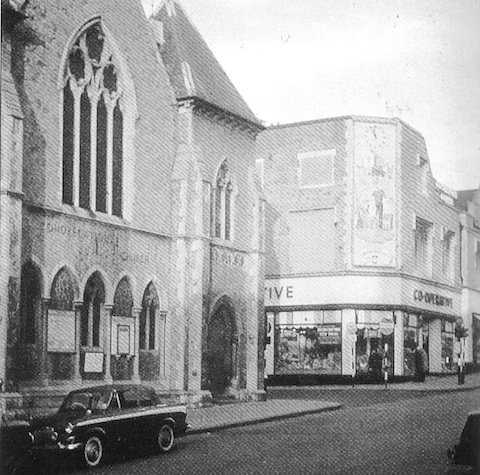
Co-operative Corner, the main offices and store of the Guildford & District Co-operative Society Ltd.
Do you recall the old Co-op “divi” number you gave when buying items at shops in the Guildford area? Chances are, if you are over a certain age it will be etched on your mind like a military service number.
And do you recall Co-op milk and bread tokens? Again such things that were commonplace 40 and more years ago.
In the beginning
The official history of the Co-operative movement dates from 1844 when the Rochdale Society was established, and opened its first shop.
Twenty years later the Co-operative Wholesale Society (CWS) was inaugurated in Manchester. The simple idea was that customers became members of their local society, with their own individual number, which entitled them to receive a small dividend based on all their purchases.
It was known as ‘the divi’ and became a part of British life. The co-operative idea spread throughout the country and by 1934 the CWS was a federation of more than 1,000 retail co-operative societies with a combined membership of about six million people. In that year alone its total sales were over £90 million. Compare that to its first year’s sales back in 1865 that amounted to £120,754.
The Guildford & District Co-operative Society was established in 1891, opening its first shop at 2 Woodbridge Road, next door to the Wesleyan church (now the site of Barclays bank). After a very short time these premises were found to be unsuitable and the business was transferred to a shop on the corner of Woodbridge Road and Leapale Road. [thethe-image-slider name=”Guildford Co-op”]
However, many Guildfordians will remember the buildings the Guildford & District Co-operative Society occupied from North Street and down Haydon Place. It first moved there in September 1895. The society purchased land bordering Haydon Place and The Bars from Mr Hart – a greengrocer and florist.
By the late 1920s and early 30s the Hart family owned land and property from North Street down to Drummond Road off Woodbridge Road. In time the co-operative society erected buildings in Haydon Place from The Bars through to the Surrey Arms pub in North Street.
A poem written at about that time by a Mr W. E. Minty, goes:
What is this place most famed in Guildford town? Where is the shopping centre of renown?
Renowned amongst the thrifty folk who save, Ere while they spend (how wisely they behave!).
You turn off North Street at the Surrey Arms, Along that narrow way and test the charms.
Of Co-op furniture, bread and cake, And outfitting and boots of stylish make.
The drapery you cannot fail to see, Also the meat, tobacco, grocery.
And hardware too, but these are not the whole, The milk department lurks everywhere, and coal.
Oh Haydon Place your width is very small, Yet would you cater for us one and all.
The movement that is speeding o’er the land, Is magic, and you also must expand.
Expansion and a new Co-op dairy opens
In the early 20th century, the Guildford & District Co-operative Society expanded at a rapid rate, opening shops in surrounding towns and villages and started home deliveries of milk, bread, coal, and, in 1931, travelling butcher’s shops.
In 1935, owing to the huge increase in the milk trade, the Guildford society in conjunction with the Aldershot and Woking Co-ops opened a modern dairy in Woodbridge Road (now Ladymead). The design of the dairy was widely acclaimed and in architectural terms a credit to the town in the then latest Art Deco style.
A booklet published at the time stated: “The building has been designed upon modern lines, erected in brickwork, with steel framing, and finished externally with a cement paint on the bricks, the general effect being very attractive.”
The dairy had the capacity to process 1,000 gallons of milk an hour. From the time the milk arrived and was tipped into a receiving tank and until it was filtered into bottles and sealed, it did not come into contact with air – “thus avoiding the risk of contamination”.
The dairy’s synchro-washing-filling unit had the ability of washing two sizes of bottles, being regularly and consistently delivered to the filling and capping machines.
The filled bottles were then placed into crates and put into the dairy’s cold storage room until collected by the roundsman.
[thethe-image-slider name=”Guildford Co-op 3″]
First self-service shop
The Guildford Co-op’s branch along Stoughton Road in Bellfields was probably the first food shop in the town to become a self-service store.
It was converted in 1950, and the idea that you, the customer, walked around filling a basket yourself and paying for it at the end was very novel indeed. So much so, that there were signs in the shop reminding customers not to take the wire baskets away with them!
Because rationing was still in force for certain items, there was a counter with a shop assistant that supplied rationed items such as canned and dried fruit, chocolate biscuits, treacle, syrup, jellies and mincemeat.
More than just a retail organisation
The Guildford Co-op’s 229th report and balance sheet for the year ending January 28, 1957, states that at that time its branches were: Woodbridge Hill, Madrid Road, Addison Road, Woking Road, Southway, Weyside Road, Stoughton Road, Worplesdon Road, Guildford; High Street, Cranleigh; North Street, Leatherhead; East Street, Horsham; South Street, Dorking; Station Road, Gomshall; Leatherhead Road, Bookham; King’s Road, Shalford; Crawley Road, Roffey, Horsham; High Street, Billingshurst; Henfield Road and Partridge Green. It’s central premises and registered office was Haydon Place, Guildford. Sales for that period amounted to just over £2 million. Total membership of people entitled to the ‘divi’ was 39,243.
The report stated that the North Street-Haydon Place development “is now known as Co-operative Corner”. Many will recall the coloured panel on the building that had previously been the Borough Halls. The panel featured a man and a woman, two children, scenes from the town including Guildford Cathedral, and a clock.
It added that “Co-operative Corner has been fully operating since March of last year [1956] and the increases in sales in those departments concerned has been encouraging.” And: “The hardware section of the central furnishing department, now located at the central premises, continues to progress and represents the value of specialization in this important section of our members’ requirements.”
But the Guildford Co-op, like others up and down the country, was not all about selling goods and services. It ran a thriving education committee. The 1957 report gives a good insight into what it was achieving in the local community. It stated: “The emphasis continues to be on our children’s groups and between 300 and 350 children attend our various groups and classes each week. A boys’ club has been opened in Guildford. It is hoped that it will have the effect of improving the ratio of boys to girls in our groups as a whole.”
It also stated that the girls drama group gained a certificate of merit in the previous Guildford Youth Drama Festival. For adults there was a music club and handicraft classes, while a series of talks on ‘colour and design in your home’, held at Dorking and Guildford, attracted about 60 people.
There were eight visits to CWS factories and establishments for staff, with nearly 250 employees taking part. Members of staff were also kept informed of all that was going on in the Co-operative movement by way of “wall newspapers”. Bulletins were published quarterly and at Guildford were prominently displayed on a stairway at Co-operative Corner.
At the time the Guildford Co-op also published its own monthly journal – the Co-operator. It was produced by the publicity department in Guildford that was headed up by Leslie Codd. Manchester-born, he came to Guildford to work for the Co-op and also became an outspoken local Labour councillor and was also a Mayor of Guildford.

A page from the August 1948 edition of the Co-operator’s pictorial souvenir of the Co-operative Day celebrations at Stoke Park.
The August 1948 edition of the Co-operator, for example, has a pictorial souvenir of the Co-operative Day celebrations at Stoke Park that took place on July 3 of that year.
The report of the event was proud to announce that 15,000 people attended and the “sun shone for the first time for some weeks”. Nearly 3,000 Co-operative members were brought to Guildford in six special trains.
The day opened with the crowning of the “Queen”, Miss Phyllis Francis. There was a pageant directed by Leslie Codd’s wife, plus there was a fancy dress parade, sporting activities, and lots of entertainment that included a road safety display. There was also a display of tent pitching, and folk dancing, trained dog displays, ballet dancing and a display by the Women’s League of Health and Beauty.
[thethe-image-slider name=”Guildford Co-op 2″]
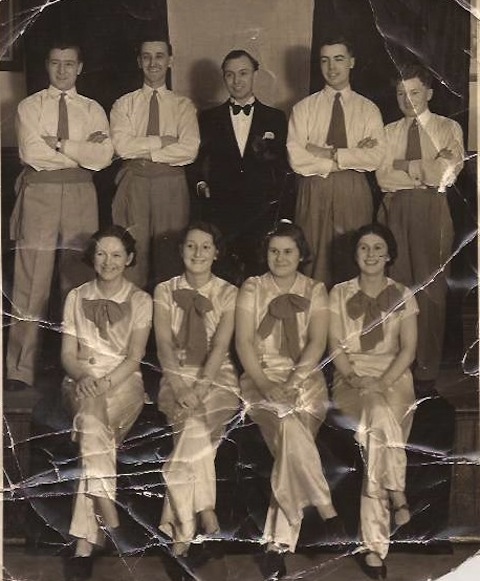
Co-op concert party. Some of those picture are: Ted Wink (far right), front row: Joan Steer, Joan Dean, Eileen Hoard and Cissy Brooks.
The Co-operator journal also rounded up other news going on in the Guildford Co-op Society relating to its developments and staff news. Co-author of this article David Rose’s mother worked in the publicity department of the Guildford Co-op in the 1950s; and when he was born in 1959 there was an announcement of his birth in the corresponding edition of the journal!
On the back page of the August 1948 journal there was a cartoon strip that was the fourth installment of “The History of the Trade Union Movement”, all good socialist stuff!
Milk and bread tokens
Co-op tokens, or checks as they are sometimes known, were used extensively in the Guildford district from the end of the 19th century right up to the late 1960s. Then a triplicate paper book-keeping accounting “Climax” system was introduced gradually throughout the UK’s Co-op shops.
A few Co-ops still continue to use pre-payment tokens for bread and milk today, Carlisle being one documented area.
The Guildford Co-op did not use dividend or mutuality checks, but did use pre-payment tokens for bread and milk, as follows.
Guildford Co-operative Society Ltd (from 1891)
Small loaf, uniface, triangular bronze, 27mm x 25mm
Small loaf, uniface, triangular aluminium, 27mm x 25mm
Guildford & District Industrial Co-operative Society Ltd (title change probably after takeover of the Horsham Society in 1921)
Half quartern, rev, border and circle, octagonal bronze 25mm
Half quartern, rev, border only, octagonal bronze, 26mm
Half quartern, uniface, zinc, 25mm
Half quartern, uniface, oval aluminium, 31mm x 21mm
Half quartern, uniface, oval zinc, 31mm x 21mm
Milk, rev, border and circle, bronze, 22mm milled edge
Milk, rev, border and circle, bronze, 22mm plain edge
Milk, uniface, square aluminium, 19mm
Guildford Co-operative Society
Large loaf, rev, light blue plastic
Co-op Dairy Society Ltd (Guildford)
From 1935. Pre-payment tokens were used extensively when delivering milk to customers. They meant that the roundsman’s delivery was speeded up with fewer cash transactions, they were more hygienic and there was less risk of robbery.
Milk, bracteates, tinned iron, 23mm
Milk, rev same, brass, 22mm plain edge
Milk, rev same, aluminium, 22mm plain edge
Milk, design as the previous two but with smaller lettering, aluminium
Milk, rev same, orange plastic, 22mm
Milk, reverse same, green plastic, 22mm
There is a standard work of reference for Co-op tokens – the Catalogue of Co-operative Checks and Tokens, compiled by Douglas Roy Rains. His is a growing database of tokens and checks issued by the Co-operative society.
Since its most recent publication in 2004, no new examples from the Guildford Co-operative Society have come to light, but that’s not to say there are others out there yet to be recorded.
The end draws near
The Guildford & District Co-operative Society merged with the Royal Arsenal Co-operative Society on January 25, 1971, and at that time its annual sales were £2.3 million. In addition to its central premises in Guildford (Haydon Place and North Street) the society operated 14 grocery shops, three of which offered a range of non-food items.
The Guildford store had 42,000 members and 350 employees. Share capital totaled more than £560,000. But the heyday of the Co-op in Guildford was coming to a close. Over the next 10 years or so its department store in the town centre and its services were discontinued. The food hall, facing on to North Street, was the last to go.
Since the demise of the store in North Street / Haydon Place, nationally the Co-op has gone through many changes and re-brandings.
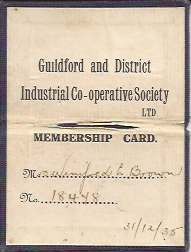
A Guildford Co-op membership card. The number on this one is 18448. Mostly, you just gave the cashier your number, there was no need to produce the card!
Today in the UK we have the Co-operative Group, with more than 4,000 stores and a range of other services such as funeralcare, travel agents, and banking, for example.
In the mid 1990s the Co-op finally did away with the old dividend scheme and introduced a loyalty card scheme like other major UK stores. Although inspired by the ‘divi’ system, all customers and not just Co-op members could sign up to the scheme.
However, in 2006 the Co-operative Group relaunched “true” dividend whereby a proportion of the profits of the Co-operative Group is returned to members.
Of course, now we have a plastic card that is swiped when making purchases. But old traditions remain in the memory. David Rose still remembers his family’s divi number – 160. In fact that’s quite an early one. He thinks his grandmother must have joined the Guildford Co-op Society in its early days. He could recite it nowadays to the always helpful young people on the tills at his local Co-op, but they’d probably wonder what on earth he was on about!
In writing this article a number of sources and publications were consulted. Stan Newman thanks the Guildford Institute where he discovered a copy of a book, Fifty Years of Service, The History of the Guildford & District C0-operative Society 1891-1941, by Leslie Codd. A number of pictures of the Guildford premises featured here have been reproduced from that book.
David Rose has a few of copies of the Co-operator journal and a number of photos relating to the Guildford Co-op in his archive. Those pictures used here he copied by kind permission from Edna Pound and also Sheila Atkinson who has a collection of pictures that belonged to Doris Dean who worked for the Guildford Co-op for many years.
Finally, the authors are always interested in hearing from people with other memories of the Guildford Co-op (why not add a reply in the box below) or if anyone has other photos. John Theobald in particular would love to hear from readers who may have any Co-op tokens, or other similar tokens. David Rose is always keen to add Guildford Co-op Dairy milk bottles to his collection and a metal crate would would be especially welcome! If you can help, call David Rose on 01483 838960, or email: drosedragon@gmail.com
Responses to Days of the Guildford Co-operative Society and the ‘Divi’

"Found any?" - "Nope, it all looks green to me!" (See Opinion: The Future is Congested, the Future is Grey)
www.abbotshospital.org/news/">





Recent Articles
- Latest Evidence in Sara Sharif Trial
- Ash’s New Road Bridge Is Named – and November 23rd Is Opening Day
- Class A in Underwear Leads to Jail Sentence
- Historical Almshouse Charity Celebrates Guildford in Bloom Victory
- Notice: Shalford Renewable Showcase – November 16
- Firework Fiesta: Guildford Lions Club Announces Extra Attractions
- Come and Meet the Flower Fairies at Watts Gallery
- Updated: Royal Mail Public Counter in Woodbridge Meadows to Close, Says Staff Member
- Letter: New Developments Should Benefit Local People
- Open Letter to Jeremy Hunt, MP: Ash’s Healthcare Concerns


Recent Comments
- Paul Spooner on Ash’s New Road Bridge Is Named – and November 23rd Is Opening Day
- Harry Eve on Opinion: The Future is Congested, the Future is Grey
- Nigel Keane on Letter: New Developments Should Benefit Local People
- Nathan Cassidy on Updated: Royal Mail Public Counter in Woodbridge Meadows to Close, Says Staff Member
- T Saunders on Opinion: The Future is Congested, the Future is Grey
- Jim Allen on Updated: Royal Mail Public Counter in Woodbridge Meadows to Close, Says Staff Member
Search in Site
Media Gallery
Dragon Interview: Local Artist Leaves Her Mark At One of England’s Most Historic Buildings
January 21, 2023 / No Comment / Read MoreDragon Interview: Lib Dem Planning Chair: ‘Current Policy Doesn’t Work for Local People’
January 19, 2023 / No Comment / Read MoreA3 Tunnel in Guildford ‘Necessary’ for New Homes, Says Guildford’s MP
January 10, 2023 / No Comment / Read More‘Madness’ for London Road Scheme to Go Ahead Against ‘Huge Opposition’, Says SCC Leader
January 6, 2023 / No Comment / Read MoreCouncillor’s Son Starts Campaign for More Consultation on North Street Plan
December 30, 2022 / No Comment / Read MoreCounty Council Climbs Down Over London Road Works – Further ‘Engagement’ Period Announced
December 14, 2022 / No Comment / Read MoreDragon Interview: GBC Reaction to the Government’s Expected Decision to Relax Housing Targets
December 7, 2022 / No Comment / Read MoreHow Can Our Town Centre Businesses Recover? Watch the Shop Front Debate
May 18, 2020 / No Comment / Read More




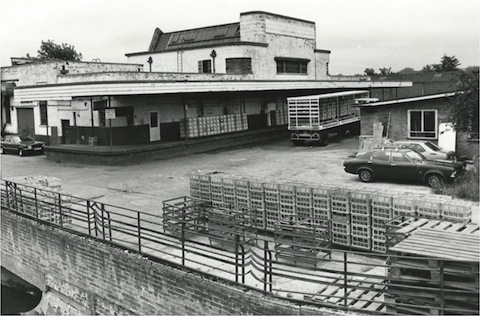

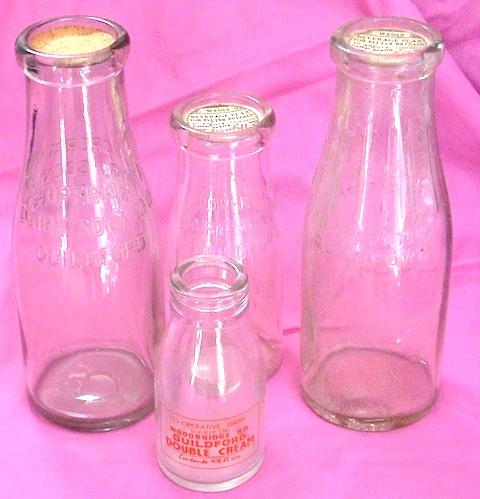
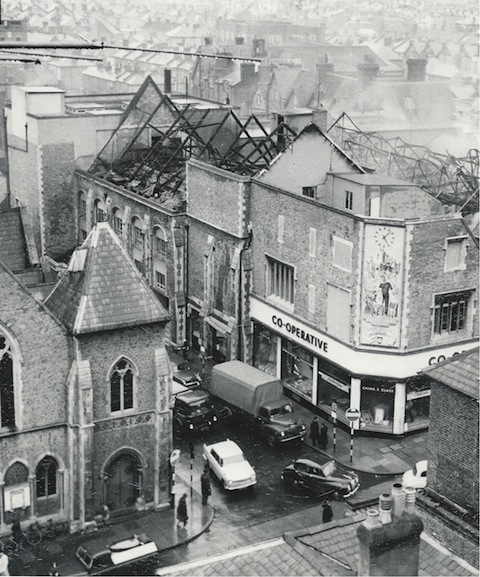
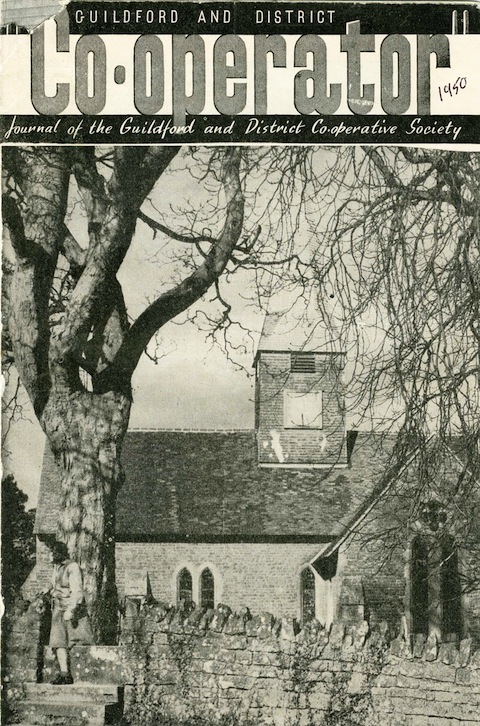
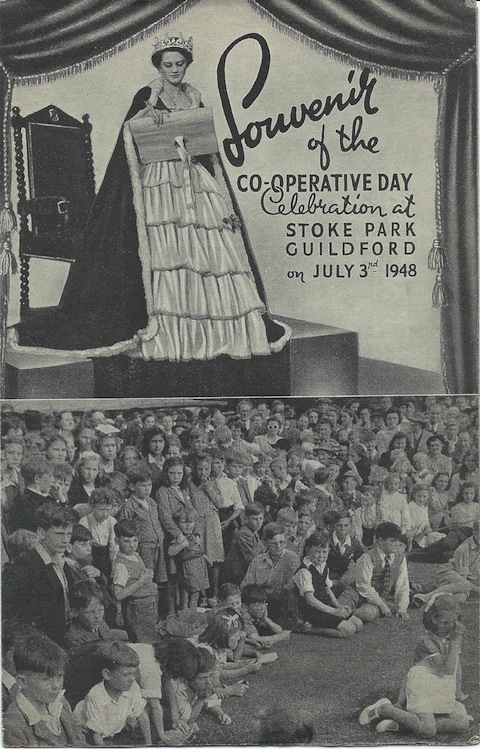

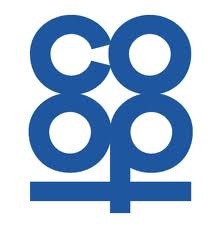




Chris Townsend
September 1, 2012 at 12:03 pm
I have doubts about the photo believed to depict the Madrid Road store. If I remember correctly, in the 50’s that store had three sections, with a central self-service grocery section, butchery to its right, and greengrocery to the left. The building in the photo appears to have a curved facade, whereas I remember it being straight. I don’t recall a Belisha beacon on Madrid Road at all. It would have been opposite the foot of Agraria Road, an awkward place for a crossing. On the other hand, if it’s not Madrid Road, then where is it?
Brian Holt
September 2, 2012 at 6:09 pm
Yes I still remember our old Co-op “Divi” number which was 12563.
Every Saturday morning I went with my mother to get the bread and milk tokens.
We also had our coal from the Co-op.
My brother was a confectioner/baker at their bakery until it closed.